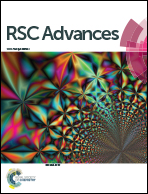The role of substrate purity and its crystallographic orientation in the defect density of chemical vapor deposition grown monolayer graphene†
Abstract
Defect free mono-layer graphene sheet growth has remained a challenge towards its huge potential applications in electronic and photonic devices. Here, we are reporting about the role of the copper substrate purity and its crystallographic orientation in the quality of the graphene grown using a low pressure chemical vapor deposition technique. Graphene is grown on three different (Cu-I, Cu-II and Cu-III) substrates of different purity under analogous conditions of optimized pre-growth annealing and cleaning processes. Irrespective of the purity level of all the substrates, it is demonstrated that monolayer graphene (IG′/IG ∼ 4) with different defect density is observed. The amount of defects and the defect density in the three samples is correlated with the different lattice planes of Cu, which are participating during the growth process. The size of the lattice grain advance upon annealing is observed and it is substrate purity dependent. This reveals that graphene growth is favored by either the (111) or the (100) plane or both. It is demonstrated that the substrate purity is extremely accountable for the growth of defect free monolayer graphene for device applications which require ballistic transport properties.


 Please wait while we load your content...
Please wait while we load your content...